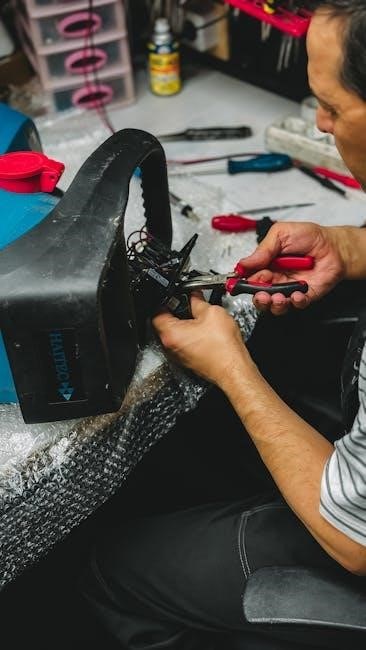The Canonet QL17 is a compact 35mm film camera featuring a high-quality 40mm f/1.7 lens, known for its portability and excellent image quality, making it a favorite among enthusiasts.
Overview of the Canonet QL17
The Canonet QL17 is a highly regarded 35mm rangefinder camera known for its sleek design, portability, and impressive performance. It features a fast 40mm f/1.7 lens, making it ideal for low-light photography. The QL system allows for quick and easy film loading, while its automatic and manual modes offer flexibility for photographers of all skill levels. Built with durability in mind, the QL17 combines a sturdy metal body with precise engineering, ensuring reliable operation. Its compact size and intuitive controls make it a favorite among street photographers and film enthusiasts seeking a versatile, high-quality camera.
- Compact and lightweight design for easy handling.
- Fast 40mm f/1.7 lens for excellent low-light performance.
- Quick Load system simplifies film loading.
- Combines automatic and manual shooting modes.
- Durable construction with a focus on precision engineering.
Key Features and Specifications
The Canonet QL17 is equipped with a 40mm f/1.7 lens, offering exceptional sharpness and low-light performance. It features a shutter speed range of 1/4 to 1/500 seconds, plus a bulb mode for extended exposures. The camera supports both manual and automatic modes, providing flexibility for creative control. Its built-in CdS meter ensures accurate exposure readings, while the QL (Quick Load) system streamlines film loading. The lens is coupled to a precise rangefinder, enabling accurate focusing. Additionally, the camera includes a self-timer, flash synchronization at 1/125 seconds, and uses a single 625 mercury battery for power. Its compact design and robust construction make it a reliable choice for photographers.
- 40mm f/1.7 lens with 6 elements in 4 groups.
- Shutter speeds: B, 1/4 to 1/500 seconds.
- Aperture range: f/1.7 to f/16.
- Built-in CdS exposure meter with automatic mode.
- Flash synchronization at 1/125 seconds.

Film Loading and Initial Setup
The Canonet QL17 features a Quick Load (QL) system for easy film loading. Open the back, align the film leader with the mark, close, and advance effortlessly.

Step-by-Step Guide to Loading Film
Open the camera back by pulling the release latch.
Attach the film leader to the take-up spool, aligning the arrow on the film with the mark on the spool.
Ensure the film is properly seated and the leader is securely attached.
Close the camera back gently and advance the film by turning the film advance lever until it stops.
The frame counter will automatically set to 1, indicating the camera is ready to shoot.
This QL system simplifies the process, making film loading quick and intuitive.
Understanding Film Advance and Rewind
The Canonet QL17 features a smooth film advance mechanism. To advance the film, turn the film advance lever clockwise until it stops. This action cocks the shutter and moves the film to the next frame. The frame counter will increment accordingly. For rewinding, locate the rewind knob on the bottom of the camera. Turn it clockwise while pressing the rewind release button to engage the rewind mechanism. Continue until the film counter returns to “S,” indicating the film is fully rewound. This process ensures safe and efficient handling of your film roll.

Exposure Control and Metering
The Canonet QL17 offers a sophisticated exposure control system, combining aperture and shutter speed adjustments with a built-in light meter for precise and effortless exposure settings.
Using the Aperture and Shutter Speed
The Canonet QL17 provides precise control over exposure with its aperture and shutter speed settings. The aperture ring, marked with f-stops, allows manual adjustment from f/1.7 to f/16. For automatic mode, set the ring to the “A” position, enabling the camera to adjust the aperture automatically. Shutter speeds range from 1/4 second to 1/500th of a second, with a “B” setting for extended exposures. To use manual mode, release the aperture ring from the “A” position and adjust both aperture and shutter speed freely. This dual control system ensures versatility for achieving desired creative effects in various lighting conditions, making it ideal for both beginners and experienced photographers. The camera’s portability and intuitive design further enhance its usability for capturing high-quality images effortlessly.
Manual and Automatic Modes Explained
The Canonet QL17 offers both automatic and manual modes for flexible shooting. In automatic mode, the aperture is set to “A,” allowing the camera to adjust settings based on the built-in meter. For manual control, release the aperture ring from the “A” position to adjust both aperture and shutter speed independently. This feature provides creative freedom for photographers. The automatic mode is ideal for quick shots, while manual mode suits those who prefer precise control. The camera’s meter ensures accurate exposures in automatic mode, making it user-friendly for all skill levels; This dual-mode system enhances versatility for capturing high-quality images in various conditions.

Flash and Synchronization
The Canonet QL17 supports external flash synchronization via its hot shoe and X-sync, enabling precise control over flash photography and minimizing overexposure in various lighting conditions.
Syncing with External Flash Units
The Canonet QL17 allows seamless synchronization with external flash units via its hot shoe and PC terminal, ensuring precise flash timing. To attach an external flash, align the flash unit with the hot shoe and gently slide it into place until it clicks. For non-dedicated flashes, use the PC sync cord to connect the flash to the camera’s PC terminal. Set the shutter speed to the X-sync setting (1/125s) for proper synchronization. This setup enables optimal flash performance, avoiding overexposure and ensuring balanced lighting in your photographs. Always test the flash connection before shooting to confirm proper synchronization.
Best Practices for Flash Photography

For optimal flash photography with the Canonet QL17, ensure the flash is synchronized correctly and the shutter speed is set to 1/125s or slower. Use bounce flash techniques to soften light and reduce harsh shadows. Avoid direct flash to minimize red-eye and overexposure. Test the flash output with a trial shot to adjust settings as needed. When using external flashes, ensure they are compatible with the camera’s sync terminals. Keep the flash unit clean and free of obstructions for consistent performance. Always carry extra batteries for the flash to avoid interruptions during shoots. Proper flash usage enhances your photos’ lighting and overall quality.

Focusing and Composition
The Canonet QL17 features a precise focusing lever for sharp images. Use the viewfinder to frame shots, ensuring subjects are well-centered or creatively composed using the rule of thirds. Natural light enhances results, while leading lines guide the eye to the focal point, creating balanced and visually appealing photographs. Proper focus and composition are essential for capturing life’s moments with clarity and artistry.
Using the Focusing Lever
The Canonet QL17’s focusing lever is designed for precise control over focus. Locate the lever on the front of the camera, near the lens. To focus, move the lever back and forth until your subject appears sharp in the viewfinder. The lever operates smoothly, allowing for quick adjustments. For close-up shots, ensure the lever is set to the appropriate distance mark. Proper use of the focusing lever ensures sharp images and accurate representation of your subject. Practice using the lever to master manual focus and achieve professional-quality results with ease.
Composition Tips for Better Photos
Mastering composition with the Canonet QL17 enhances your photography. Use the rule of thirds by placing subjects off-center for balanced frames. Experiment with leading lines to guide the viewer’s eye. Take advantage of natural light, shooting during the golden hour for warm tones. The 40mm f/1.7 lens excels in low light, allowing for creative bokeh. Pay attention to symmetry and patterns in your surroundings. Don’t forget to check focus and exposure before capturing. These tips, combined with the QL17’s portability, will help you create stunning, professional-looking images effortlessly.

Troubleshooting and Maintenance
The Canonet QL17 may face issues like battery drain or shutter lag. Regular cleaning and lubrication help. Consult the repair manual for complex fixes. Ensure proper maintenance for optimal performance.
Common Issues and Solutions
The Canonet QL17 may experience issues like jammed film advance or shutter lag. To resolve these, rewind the film and reload properly. Battery drain is common; use Wein Air batteries and ensure the meter is off when not in use. If the shutter sticks, clean the lens and internals gently. For persistent problems, consult the repair manual or seek professional servicing. Regular maintenance, including cleaning and lubrication, helps prevent malfunctions and ensures optimal performance. Always refer to the manual for detailed troubleshooting steps to maintain your camera’s functionality and longevity.
Basic Maintenance and Care Tips
Regular maintenance ensures the Canonet QL17’s longevity. Clean the lens and viewfinder with a microfiber cloth and air blower to prevent dust buildup. Lubricate moving parts like the film advance lever and focusing ring periodically. Store the camera in a cool, dry place, away from direct sunlight, and use silica gel packets to avoid moisture damage. Replace worn-out light seals and check the shutter curtains for tears. Use Wein Air batteries to maintain proper functionality. For long-term storage, keep the camera loaded with film to prevent shutter mechanism strain. Always consult the manual for detailed care instructions.
